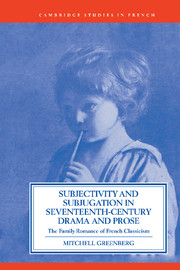 Subjectivity and Subjugation in Seventeenth-Century Drama and Prose
Subjectivity and Subjugation in Seventeenth-Century Drama and Prose Book contents
- Frontmatter
- Contents
- Preface
- Introduction
- 1 L'Astrée and androgyny
- 2 The grateful dead: Corneille's tragedy and the subject of history
- 3 Passion play: Jeanne des Anges, devils, hysteria and the incorporation of the classical subject
- 4 Rodogune: sons and lovers
- 5 Molière's Tartuffe and the scandal of insight
- 6 Racine's children
- 7 “Visions are seldom all they seem”: La Princesse de Clèves and the end of Classical illusions
- Notes
- Index
- Cambridge Studies in French
6 - Racine's children
Published online by Cambridge University Press: 16 October 2009
- Frontmatter
- Contents
- Preface
- Introduction
- 1 L'Astrée and androgyny
- 2 The grateful dead: Corneille's tragedy and the subject of history
- 3 Passion play: Jeanne des Anges, devils, hysteria and the incorporation of the classical subject
- 4 Rodogune: sons and lovers
- 5 Molière's Tartuffe and the scandal of insight
- 6 Racine's children
- 7 “Visions are seldom all they seem”: La Princesse de Clèves and the end of Classical illusions
- Notes
- Index
- Cambridge Studies in French
Summary
Est-ce qu'en holocauste aujourd'hui présenté,
Je dois, comme autrefois la fille de Jephté,
Du Seigneur par ma mort apaiser la colère?
(Athalie, IV, i, 1259–1261)“Sa haine va toujours plus loin que son amour.”
(Mithridate, I, v, 354)“La grande angoisse humaine est de tendre les bras vers un être qui se révèle meurtrier.”
(Ch. Mauron)Among the innovations he brought to the seventeenth-century theatre, Racine was, we are told, the first to place a child on the stage. This novelty transforms the world of Classical dramaturgy into a compelling scenario of horror and sacrifice; for this child, led out into the public's embrace, is brought forth upon the scene of Classicism as its victim. Racine puts children on his stage to immolate them, or at least to keep the threat of immolation suspended over their heads. The impact of this threatened slaying informs a complex vortex of dramatic, social, and psycho-sexual tensions around which swirls, in ever more opaque waves of poetic horror, the tragic message of Racinian theater. For while this child is offered up as a propitiatory victim to satisfy the anger/love of the gods, to slake the unquenchable bloodlust of his own parents and family, the tragic “frisson” of his impending immolation also functions as a lure ensnaring and appeasing the desire for theater – for a theater of cruelty and beauty, of terror and release – of the audience.
- Type
- Chapter
- Information
- Subjectivity and Subjugation in Seventeenth-Century Drama and ProseThe Family Romance of French Classicism, pp. 141 - 173Publisher: Cambridge University PressPrint publication year: 1992
